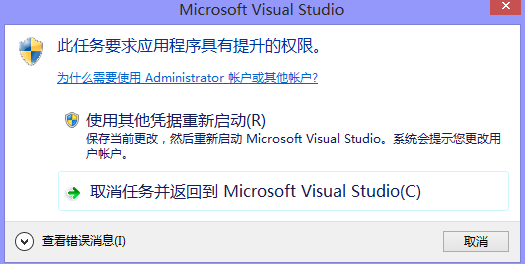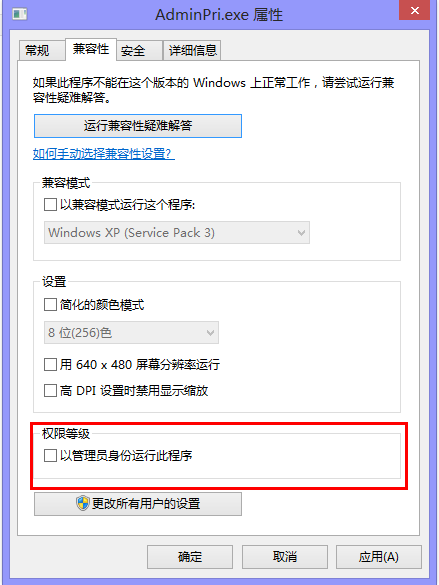在Vista 和 Windows 7 及更新版本的操作系统,增加了 UAC(用户账户控制) 的安全机制,如果 UAC 被打开,用户即使以管理员权限登录,其应用程序默认情况下也无法对系统目录、系统注册表等可能影响系统正常运行的设置进行写操作。这个机制大大增强了系统的安全性,但对应用程序开发者来说,我们不能强迫用户去关闭UAC,但有时我们开发的应用程序又需要以 Administrator 的方式运行,如何实现这样的功能呢?
下面演示 C# 程序如何实现提示用户以管理员权限运行。 本例以WinForm程序演示,新建一项目生成后进行相应修改: 方法一:通过 System.Diagnostics.Process.Start() 方式启动: 实现方法: 修改默认生成的Program文件,修改后的代码如下:
static class Program
{
[STAThread]
static void Main()
{
Application.EnableVisualStyles();
Application.SetCompatibleTextRenderingDefault(false);
/**
* 当前用户是管理员的时候,直接启动应用程序
* 如果不是管理员,则使用启动对象启动程序,以确保使用管理员身份运行
*/
//获得当前登录的Windows用户标示
System.Security.Principal.WindowsIdentity identity = System.Security.Principal.WindowsIdentity.GetCurrent();
System.Security.Principal.WindowsPrincipal principal = new System.Security.Principal.WindowsPrincipal(identity);
//判断当前登录用户是否为管理员
if (principal.IsInRole(System.Security.Principal.WindowsBuiltInRole.Administrator))
{
//如果是管理员,则直接运行
Application.Run(new Form1());
}
else
{
//创建启动对象
System.Diagnostics.ProcessStartInfo startInfo = new System.Diagnostics.ProcessStartInfo();
startInfo.UseShellExecute = true;
startInfo.WorkingDirectory = Environment.CurrentDirectory;
startInfo.FileName = Application.ExecutablePath;
//设置启动动作,确保以管理员身份运行
startInfo.Verb = "runas";
try
{
System.Diagnostics.Process.Start(startInfo);
}
catch
{
return;
}
//退出
Application.Exit();
}
}
}
效果:由于是通过System.Diagnostics.Process.Start() 方式外部调用启动,所以直接通过VS运行时,是不会提示VS也需要管理员权限,只有程序本身需要管理员权限,与生成应用程序的程序不同。这点是和方法二实现的主要不同之处。 方法二:通过添加应用程序清单文件: 在 项目 上 添加新项 选择“应用程序清单文件” 然后单击 添加 按钮 添加后,默认打开app.manifest文件,将: <requestedExecutionLevel level="asInvoker" uiAccess="false" /> 修改为: <requestedExecutionLevel level="requireAdministrator" uiAccess="false" /> 然后打开 项目属性 ,将 应用程序 标签页中的 资源 中的 清单 修改为新建的 app.manifest。 重新生成项目,再次打开程序时就会提示 需要以管理员权限运行。 需要注意的是:如果在VS中 启动调试 的话,就会提示 此任务要求应用程序具有提升的权限。如下图:
 选择 使用其他凭据重新启动 即可。 方法三:直接修改程序文件的属性 右击程序文件,在弹出的属性对话框中的 兼容性 标签页中 勾选“以管理员身份运行此程序”即可。
选择 使用其他凭据重新启动 即可。 方法三:直接修改程序文件的属性 右击程序文件,在弹出的属性对话框中的 兼容性 标签页中 勾选“以管理员身份运行此程序”即可。

判断程序是否以管理员身份运行 需要添加命名空间: using System.Security.Principal;
/// <summary>
/// 确定当前主体是否属于具有指定 Administrator 的 Windows 用户组
/// </summary>
/// <returns>如果当前主体是指定的 Administrator 用户组的成员,则为 true;否则为 false。</returns>
public static bool IsAdministrator()
{
bool result;
try
{
WindowsIdentity identity = WindowsIdentity.GetCurrent();
WindowsPrincipal principal = new WindowsPrincipal(identity);
result = principal.IsInRole(WindowsBuiltInRole.Administrator);
//http://www.cnblogs.com/Interkey/p/RunAsAdmin.html
//AppDomain domain = Thread.GetDomain();
//domain.SetPrincipalPolicy(PrincipalPolicy.WindowsPrincipal);
//WindowsPrincipal windowsPrincipal = (WindowsPrincipal)Thread.CurrentPrincipal;
//result = windowsPrincipal.IsInRole(WindowsBuiltInRole.Administrator);
}
catch
{
result = false;
}
return result;
}






















 3289
3289

 被折叠的 条评论
为什么被折叠?
被折叠的 条评论
为什么被折叠?








